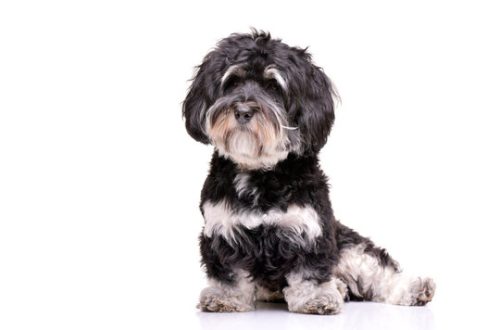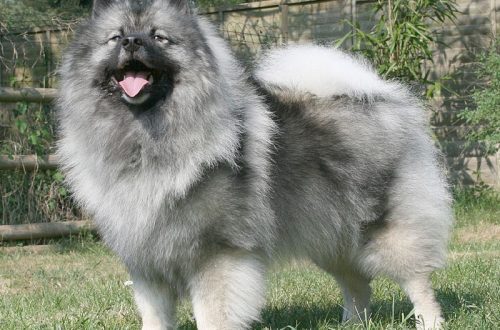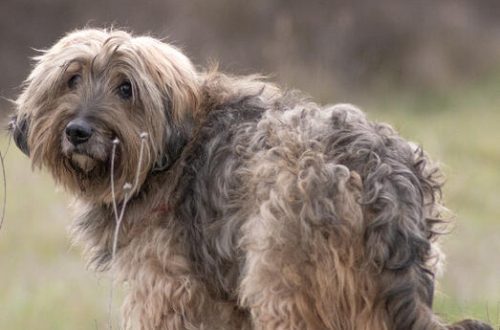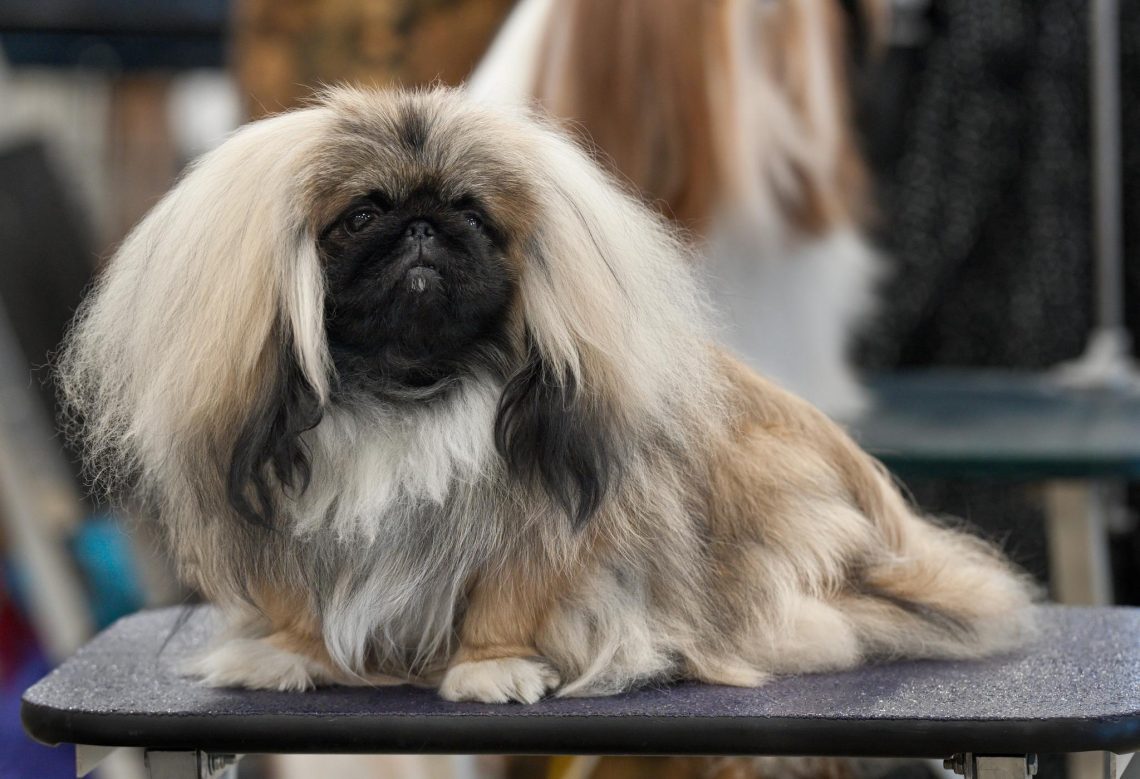
pekingese
Other names: Chinese Spaniel , Peking Palace Dog
Pekingese is an ancient breed of decorative dogs with short legs, “flattened” muzzles and fluffy hair, bred in China.
Kaundan
- Mga Kinaiya sa Pekingese
- Panguna nga mga gutlo
- Kasaysayan sa lahi sa Pekingese
- Video: Pekingese
- Pekingese breed standard
- Photo of Pekingese
- The nature of the Pekingese
- Edukasyon ug pagbansay-bansay
- Pagpadayon ug pag-atiman
- Health and disease of the Pekingese
- Sa unsa nga paagi sa pagpili sa usa ka itoy
- Photo of Pekingese puppies
- Pekingese price
Mga Kinaiya sa Pekingese
| Nasod nga gigikanan | China |
| Ang gidak-on | Gamay |
| Pagtubo | 20-24 cm sa pagkalaya |
| Timbang | gikan sa 3 hangtod 5 kg |
| Age | hangtod sa 17 anyos |
| FCI breed nga grupo | kauban nga mga iro |
Panguna nga mga gutlo
- According to an ancient Chinese legend, the Pekingese are the descendants of a lion and a monkey, born as a result of the marriage of these two animals and inheriting from their parents a proud disposition, combined with an extraordinary appearance.
- Like all short-faced dogs, Pekingese suffer from heat. In addition, in a dream, they can make unusual funny sounds that vaguely resemble snoring or hoarse sniffing.
- With the off-scale cuteness of their appearance, the Pekingese are independent and rather arrogant pets.
- In relation to other pets, dogs are quite peaceful. The Pekingese considers it below his dignity to sort things out and arrange battles for the title of alpha male with a cat or a guinea pig.
- A few decades ago, the breed suffered greatly from commercial breeding, which resulted in whole lines of mentally unstable and frankly sick dogs.
- Pekingese do not tolerate too close physical contact, which makes them uncomfortable, so they can bite children who go too far with hugs.
- In terms of physical activity, the breed is somewhat passive, therefore, with a lack of free time, the Pekingese does not have to be walked daily.
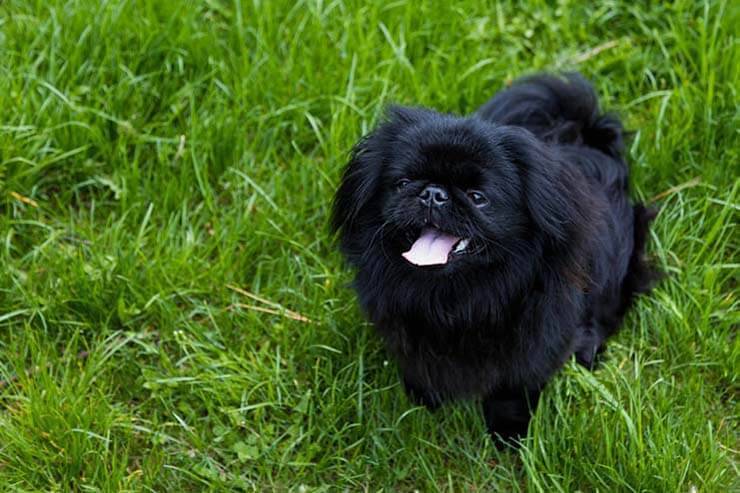
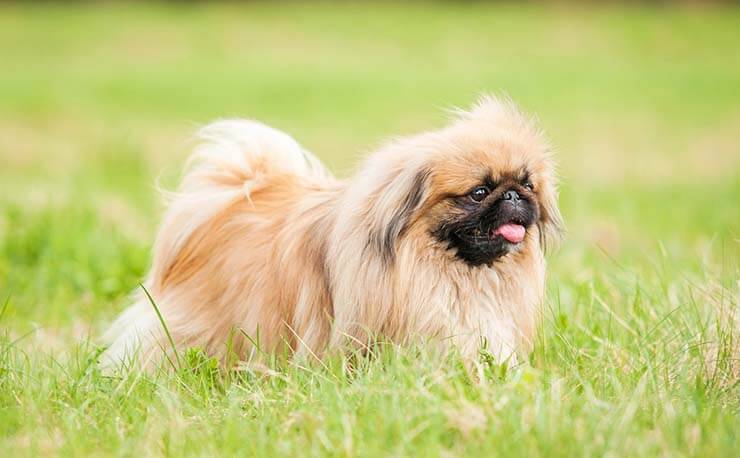
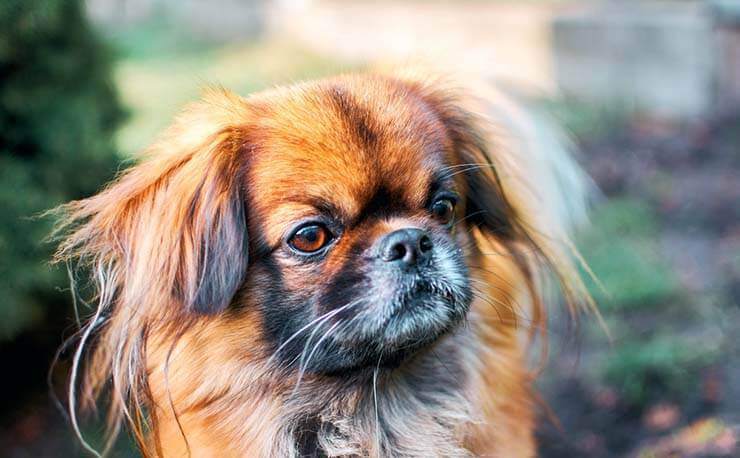
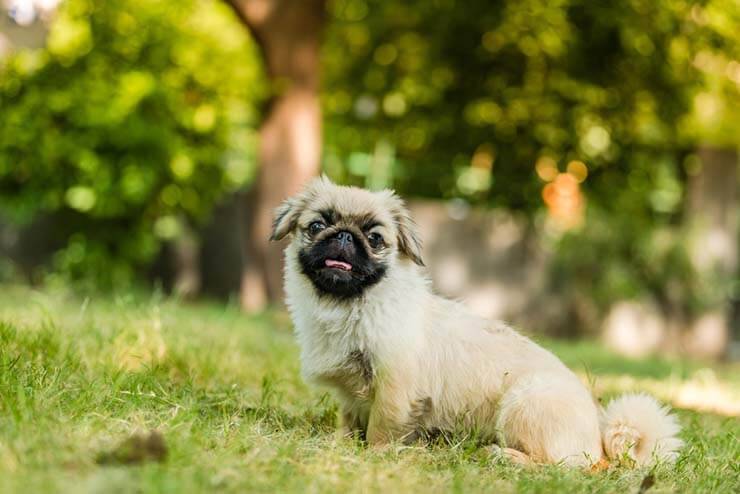
Ang Pekingese is a bright representative of the canine beau monde with an outstanding appearance and a strong independent character. Proud and moderately capricious, this little proud man will never agree to a supporting role, about which he will immediately inform his own owner. At the same time, he has an innate sense of aristocracy. Scratched wallpaper and furniture, endless complaints about loneliness in the form of annoying barking, mess in the apartment – all this is a frank bad manners for the Pekingese, which he will never allow himself.
Kasaysayan sa lahi sa Pekingese
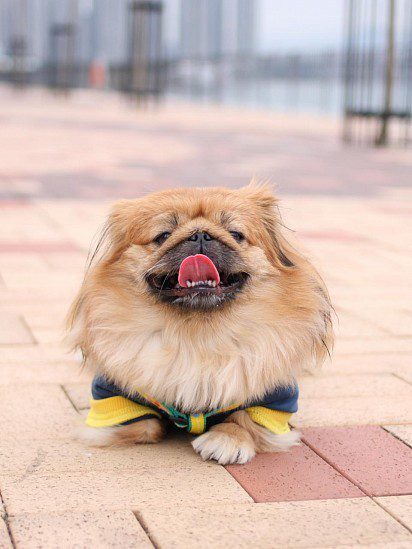
The homeland of the Pekingese is China. It was in the Celestial Empire that these arrogant fluffies were elevated to a cult, adding them to the list of the emperor’s favorite pets. According to some reports, the age of the breed has long exceeded 2000 years, but the world found out about its existence only in the 18th century. Being under the care of the Chinese rulers for centuries, the Pekingese or Fu dogs, as they preferred to be called in their homeland, have evolved into real minions of fate. Their figurines were sculpted from porcelain, legends were made about them, and the most miniature representatives of the breed rode around in the sleeves of nobles, eating selected delicacies from their table.
Chinese Pekingese sample of the XVIII-XIX centuries. it was impossible to meet people walking along the city streets, since the right to breed animals belonged to the imperial family and was inherited. This led to the fact that buying, receiving as a gift, and finally just stealing a palace puppy became virtually unrealistic. The animals were reliably guarded by the military, with whom even the most desperate thieves did not dare to compete. European breeders, who have long been looking towards the Pekingese as another Asian curiosity, of course, were not pleased with such restrictions, but then fate itself intervened in the matter.
In 1859-1860. between China, England and France, another Opium War broke out, the result of which was the storming of the residence of the emperor of the Celestial Empire. The British did not find the monarch himself, as well as members of his family, in the Summer Palace, but they found in it five miraculously surviving Pekingese, who were subsequently sent to Great Britain. From this moment, a new, European round of the history of the breed begins, giving the world decorative dogs with lion manes and monkey faces. By the way, animals were already dubbed Pekingese in England, taking as a basis the name of the Chinese capital – Beijing.
Video: Pekingese
Pekingese breed standard
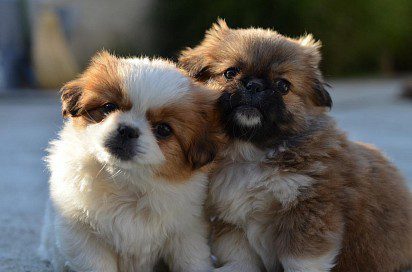

The first Pekingese, brought to Britain in 1860, looked little like modern individuals and looked more like Japanese Chins , but over time, the conformation differences between the breeds began to appear brighter. So, for example, over the years of selection and careful selection, the Pekingese have gained weight, and their legs have become significantly shorter. The main feature of the appearance of today’s “lion dogs” is an emphasized compact physique. Even with a cursory examination of the animal, one gets the feeling that it was tamped down with a miniature press from above and in front. The muzzle of the Pekingese is a separate issue, because there is very little dog in it. This is rather a funny face of an unknown fairy-tale creature with bulging beady eyes and a half-open miniature mouth, from which a neat, rough tongue protrudes.
To date, the breed exists in two types: the classic and the so-called sleeve. Sleeve Pekingese are inferior to their counterparts in size, although they are not fully “bag” pets. The weight of such individuals largely depends on the country of breeding. So, for example, in the USA and Canada, all animals that have gained more than 3 kg are rejected. And this despite the fact that the weight of representatives of this breed in their classical type reaches 5-5.5 kg. Sleeve Pekingese boughs are not knitted due to body characteristics that do not allow them to fully bear offspring, therefore, surprisingly, miniature puppies are obtained from full-sized sires.
ulo
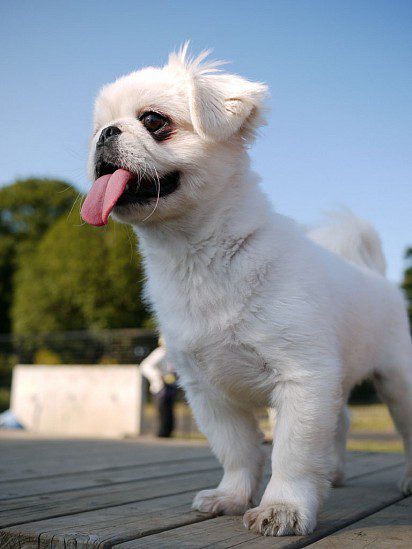

The Pekingese has a massive, strongly flattened skull between the ears with a distinct stop. The muzzle of the dog is short, stretched in breadth, bordered by a v-shaped fold, enveloping the nose bridge and ending on the cheeks.
Ngipon ug mopaak
Small, even Pekingese teeth are hidden behind the lips and are practically invisible. As for bite, a moderate undershot bite is typical for the breed (this item is not specified in the standard).
Ilong
The Pekingese has a flattened and fairly wide nose. Lobe black, brightly pigmented, with wide, well-opened nostrils.
Mata
The large round and sometimes slightly bulging eyes of the Pekingese give it a somewhat surprised look. The standard color of the iris is dark. Light-eyed individuals are regarded as plembrace and are not allowed to compete.
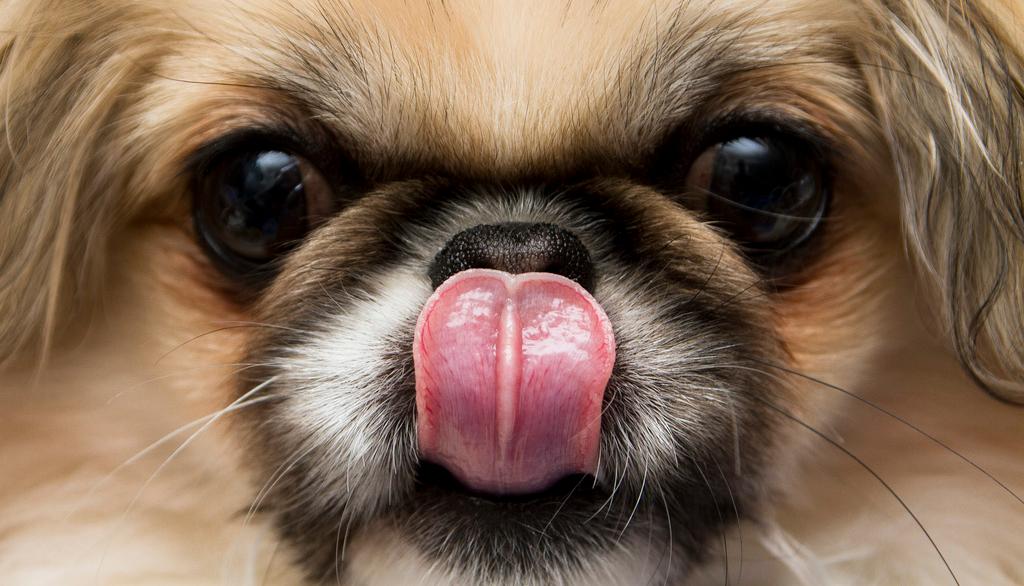

Mga igdulungog
The high-set, heart-shaped ears of the Pekingese are lowered along the head and reach the line of the lower jaw. The decorative hair on the ear cloth is long and soft.
Ang liog
Pekinese dogs have massive, short necks, which is especially noticeable when examining a pet in profile.
frame
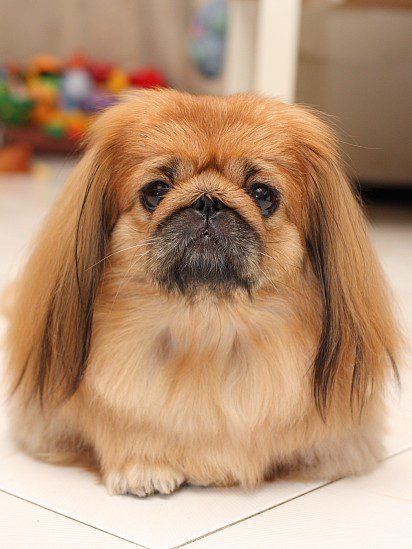

The body of the Pekingese is short, with a noticeably weighted front, a well-drawn waist and an almost straight back.
mga limbs
The front legs are short, thick and bony with shoulders looking back and elbows pressed to the sides. The hind limbs are set close to each other and are lighter in bone. The angulations of the hind legs are normal, the hocks are relatively firm. The paws of the Pekingese are large, flat, without the roundness characteristic of most breeds. The front paws are slightly turned outward, while the hind legs look straight ahead. The Pekingese moves slowly, importantly, as if rolling.
Buntag
The tail of the dog is set high and has a slight bend towards the end, which allows it to hang down to the right or left thigh.
balhibo sa carnero
Stylish “fur coats” of the Pekingese are formed by a layer of delicate undercoat and long, coarse outer hair. The dog’s neck is wrapped in a voluminous wool collar. On the ears, tail, toes and back of the legs, there is adorning hair.
Kolor
According to the standard, the Pekingese can have any coat color. Exceptions are albino dogs and liver-colored individuals.
Pagdiskwalipika sa mga bisyo
- Cryptorchidism.
- Overweight (more than 5.5 kg).
- Liver coat/albinism.
- Depigmented lips, eyelids and nose.
Photo of Pekingese
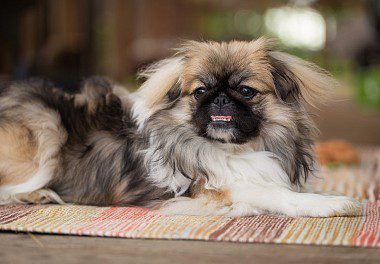

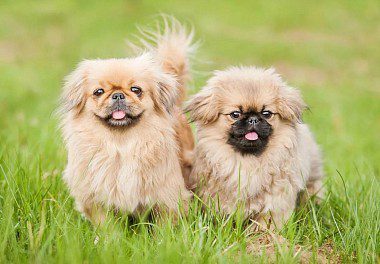

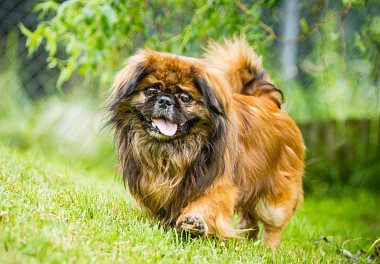

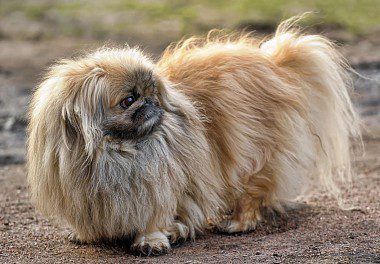

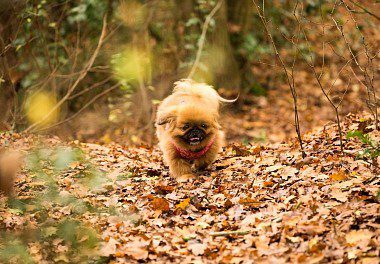

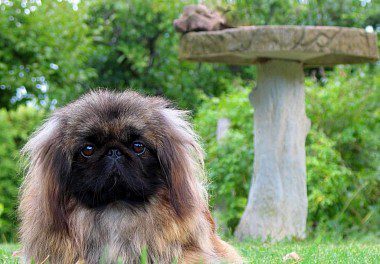

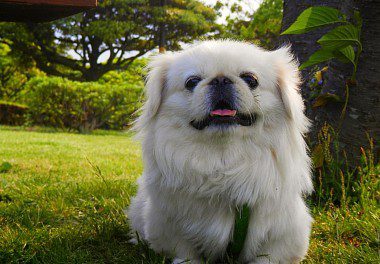

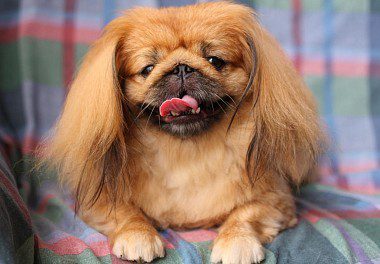

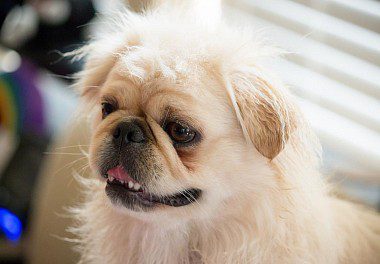

The nature of the Pekingese
The Pekingese is an arrogant fluffy nobleman who hates noise and fuss and sincerely enjoys a positive, peaceful environment and orderliness, which is why he is often recommended as a four-legged friend for older couples. In a good mood, a dog is indulgent towards caresses and tasty gifts falling at its feet, but it’s impossible to “buy” this wayward Asian sly just like that. The Pekingese are firmly convinced that the planet revolves exclusively around themselves, so they expect an appropriate attitude from the owner.
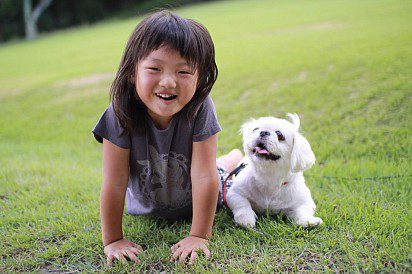

Trying to appeal to the dog’s conscience, to put pressure on it, to influence it with a cry is useless. Representatives of this breed hear only what they want to hear. Although, if rudeness is allowed in relation to the Pekingese, a lion wakes up in them, upholding its own interests to victory. And yet, the Pekingese are quite sociable guys, willingly sharing their leisure time with the owner. At the same time, they are very independent and, as it should be for royalty, they do not depend on human attention. Need to leave the descendant of Fu dogs alone for a couple of hours? No problem! A fluffy aristocrat does not get bored alone with himself, and in your absence he will willingly “comprehend Zen” on your own sofa.
With the owner of the Pekingese, from the very first days, they establish close emotional contact, which they maintain throughout their lives (provided that you have the right Pekingese, and not the hysterical ward of a commercial breeder). This helps the animals to acutely feel changes in the owner’s mood and correctly dose communication. If your fluffy suffers from excessive obsession and does not come off the knees of the household, you can congratulate yourself – you have become the owner of a perfectly disguised mestizo. Pekingese can show excessive aloofness and aristocratic coldness, but outright pestering is not characteristic of them.
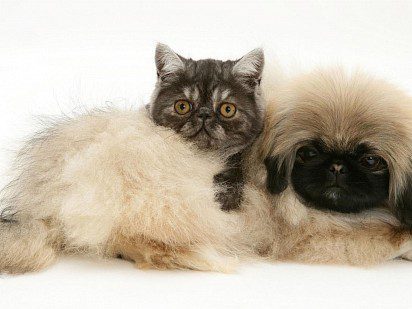

The Pekingese is not jealous and agrees to endure your long-standing love for cats, birds and other pets. At the same time, he has a pronounced Napoleon complex, which prevents the animal from building normal relationships with other dogs. The lack of growth is compensated for by the indomitable aggression that the Pekingese experience towards their larger brothers, so do not expect that the Chinese charmer will walk along the line, wagging his tail: to provoke a wolfhound calmly walking in the distance into a fight for this snub-nosed “Asian” – a matter of honor.
Due to the fact that the Pekingese is sensitive to pain and not very patient, he is unlikely to become a friend to children. The dog is indifferent to games and noisy companies, and the need to obey someone simply infuriates her. In addition, the fragile constitution leaves the animal no chance of salvation if one of your heirs inadvertently steps on it or hugs it too tightly.
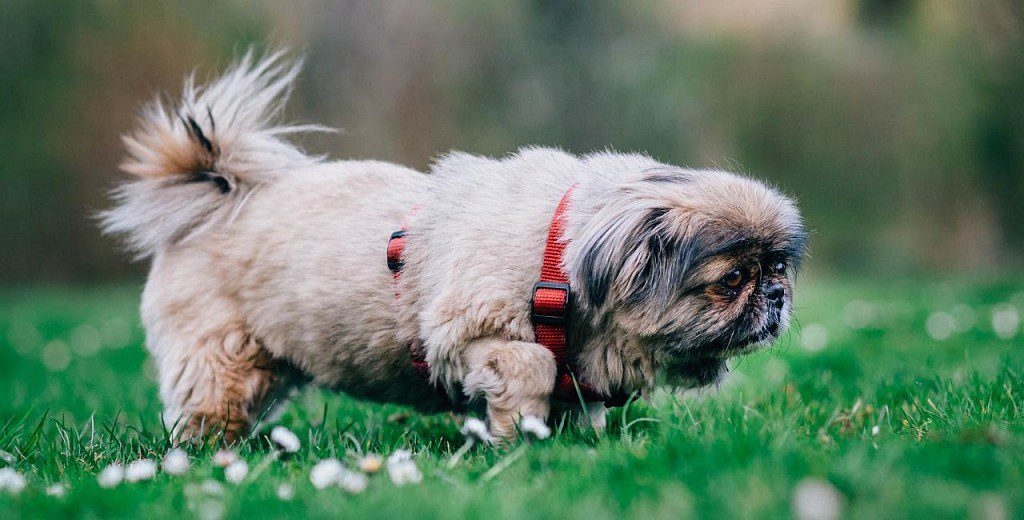

Edukasyon ug pagbansay-bansay
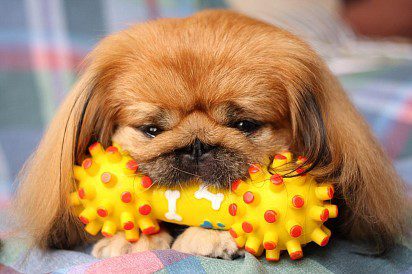

The difficult-to-educate, untrainable Pekingese is perhaps the most common cliché among fans of the breed. Yes, the “palace dogs” are self-willed and selfish, but it is quite possible to instill in them the norms of etiquette. The only thing is to change the tactics of behavior. In particular, harshness and pressure will not work with Pekingese, so get out of the habit of yelling at a pet that refuses to obey the command. But the breed is responsive to outright flattery, so praise the four-legged student even for the slightest success: it’s not difficult for you, but for the dog it’s an incentive.
You can’t do without perseverance and perseverance in training a Pekingese. Get the dog to exercise, but use gentle persuasion rather than direct orders. The pet must at all costs fulfill your requirement: immediately, in ten minutes or in half an hour, but it must. In general, indulgence towards a person is clearly seen in the behavior of the Pekingese. A dog may sincerely adore the one and only owner, but this does not prevent her from using him for her own purposes. If the animal is in no hurry to fetch the toy you have thrown, do not even think of bringing it yourself, otherwise you will not notice how you find yourself in the role of an errand boy with the pet.
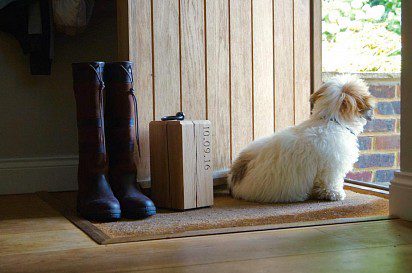

Of particular danger is adolescence, which in Pekingese puppies begins as early as 5 months of age. During this period of “breaking” the character of the Pekingese becomes frankly uncontrollable, does not want to learn anything and systematically tests the patience of the owner. This does not mean that the pet should be left alone and wait until he matures. On the contrary, forcing a teenager to train should be redoubled. If the puppy realizes that the owner is happy to put his pranks on the brakes, having matured, he is unlikely to treat him more respectfully. Of course, the Pekingese will not dare to encroach on the “throne” of the head of the family, but from time to time he will not give a damn about the requirements of the household.
As for training methods, there are no special programs focused on Pekingese. In fact, they are not needed, since standard training methods on representatives of this breed also work well. The only “but”: big-eyed pussies do not really respect teams. But on the other hand, most of the tricks from the same OKD will never come in handy for the Pekingese. So leave the drill and blind obedience to shepherd dogs, concentrating on raising endurance in the ward. In particular, from the first months of life, wean the dog to pick up sweets accidentally left by someone from the ground, help the animal get used to the idea that walking on a leash is not a punishment, but a pleasant pastime. In general, explain the rules and phenomena new to the Pekingese in such a way that their importance and necessity become clear to him.
Pagpadayon ug pag-atiman
Despite the pretentious past, in ordinary life, the Pekingese are not so spoiled persons, and they need no more attributes of comfort than any other decorative breed. So, for example, a puppy bed should not be special and super warm. An ordinary blanket is enough, laid in a corner where drafts do not blow. Where the Pekingese does not belong is near heating appliances, near which it is so easy for short-nosed “Chinese” people dressed in fluffy fur coats to overheat. By the way, do not try to shove the baby’s mattress into the most “deaf” place in the apartment. For normal development, the puppy needs to be in contact with the owner, or at least look at him from time to time from his bed. Of the obligatory dog belongings, the Pekingese will need two bowls (preferably stainless steel), a leash with a collar, absorbent diapers and litter box. Animals need toys, but you shouldn’t overwhelm your dog with them. A couple of tweeters are enough and it is desirable that these are not balls that the Pekingese, due to the structural features of the jaws, cannot grasp.
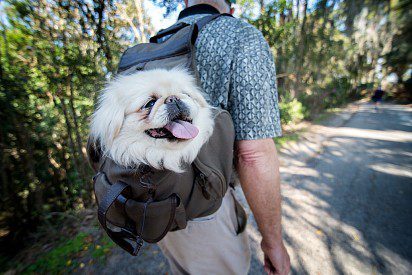

You won’t have to spend hours cutting circles in parks and squares with representatives of this breed: in terms of physical activity, the Pekingese is far from an energizer, and the structural features of the skull do not allow him to strain too much without harming his health. Usually, in order to walk freely, a Pekingese needs two visits a day for 15-20 minutes, but it all depends on the well-being and health of a particular dog. There are individuals, and there are many of them, who manage to warm up in 5-10 minutes. In addition, the breed does not tolerate heat well, so if the thermometer outside the window is +25 ° C and above, it is better to reschedule the tour for early morning or late evening. Chilly weather and severe frosts are also not a joy for the Pekingese, so on especially cold days you should completely refuse to walk.
Separately, it is worth mentioning about dog training to the toilet. Often, the Pekingese neglect this science, preferring to do their “dirty deeds” on the floor, carpets or the owner’s favorite chair. Moreover, some animals “mines” the most unexpected places even after they have fully mastered the tray. There are two ways to deal with this behavior:
- remove objects that attract dogs, if it is a carpet or bedspread;
- forbid the Pekingese to go to that part of the apartment, which he made his own toilet, blocking the entrance with a low fence.
As an alternative to rolling rugs and installing plastic fences, you can use special sprays that have a strong smell that is unpleasant for dogs. They do not scare away all individuals, but they work on some fluffy hooligans.
Important: you can not punish the Pekingese for going to the toilet past the tray, poking the dog with his nose into the products of his life. Otherwise, do not be surprised by the pet’s sophisticated revenge in the form of “fragrant gifts” in the most unexpected places.
Kalimpyo
Pekingese puppies have a special type of coat, softer and fluffier, which is why one and a half month old babies look like downy lumps with beady eyes. The change of the children’s “fur coat” to the adult “coat” occurs at about the age of 4 months, but in some individuals the process is delayed up to 32 weeks of life. During this period, the Pekingese has enough daily combing with a massage brush and treating the “panties” area and ears with a rare comb. The coat must be moistened with conditioner before combing, as Pekingese hair is already brittle. At the same time, the movements of the comb should be as careful as possible: do not pull the tangled hairs and in no case pull them out. The coat of the Pekingese is very delicate and grows slowly, so if each combing brings such losses, in a couple of months the puppy will turn into a funny bald head.
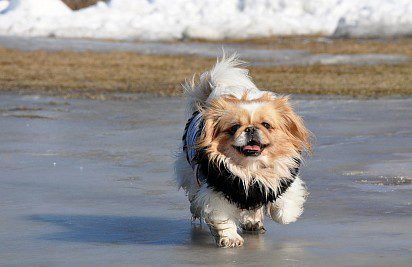

Ideally, the Pekingese is not cut or trimmed, combing and sorting out the tangles, but in some situations the rules are still violated. In particular, if the dog will never be shown in the ring and suffers greatly from the heat, his “mantle” can be slightly shortened. At the same time, it is important to understand that a haircut is a direct damage to the animal’s exterior, and it cannot be justified by one’s own laziness and lack of free time.
The ideal outwardly Pekingese is a fluffy creature with spectacular fringes on the ears, often dragging along the floor after its owner. All this beauty is 90% the result of human efforts. Firstly, because the animal will have to be taught to grooming, since not a single dog, and especially the pampered Pekingese, is delighted with the sensations that accompany the unraveling of matted hair. Secondly, because you will have to keep the coat clean and airy all year round.
Swimming is not recommended for Pekingese in principle, so they arrange them once a year or on the eve of exhibitions. Even if your ward has such a nuisance as food poisoning, and the area under the tail began to look untidy, it is not necessary to put the dog in the bath. Simply rinse the stained area under warm running water and pat dry with a towel. In general, in caring for Pekingese, experts recommend using dry powder shampoos, since water and standard hair care cosmetics spoil the dog’s hair structure, provoking its shedding. Owners who are accustomed to walking their pet in any weather can be recommended to purchase waterproof overalls in which the Pekingese coat will be reliably protected from dirt and splashes. At home, curlers will help protect hair from pollution, brittleness and tangles.
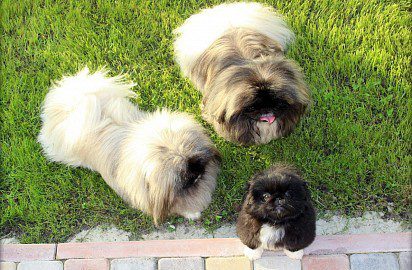

Keep your dog’s ears, eyes, and nasal folds clean. Unroll the coat a couple of times a week and look into the Pekingese’s ear funnel. If no pollution is observed inside and the ear does not stink with a sharp “ambre”, no intervention is required. The maximum that you can afford is to remove excess sulfur with a damp cotton pad. If the Pekingese began to shake his head, and an unpleasant smell floats from his ears, you will have to treat the animal at the veterinarian.
The most problematic place of the breed is the eyes. Often, as a result of injuries and heated discussions with other dogs, Pekingese eyeballs fall out. So if you got an overly bug-eyed pet, take precautions: give up the habit of patting the animal on the head and do not pull the leash on walks to sober up the dreaming dog. In addition, the anatomical features of the breed impose a number of obligations on its owner. For example, Pekingese will have to wipe the mucous membrane of the eyelids more often than other decorative dogs, since more debris and dust gets on it. Phyto-lotions or a solution of boric acid are suitable for this purpose. Washing your eyes with tea leaves is undesirable, since too stagnant infusion made from low-quality raw materials will only increase the inflammatory process. And remember
Another place that requires constant care and close attention is the crease on the dog’s muzzle. Air does not get into this impromptu wrinkle, but the lacrimal fluid in it accumulates in decent volumes, creating a greenhouse effect. Tighten the skin on the nose several times a week by wiping the crease with a dry, highly absorbent cloth. Pekingese claws are better to cut off a little, as they grow, since if the haircut is too radical, there is a risk of touching a blood vessel. It is worth taking care of the pet’s paws, especially if the dog often walks, so buy or sew waterproof slippers for the Pekingese for going out. And of course, do not neglect protective creams and vegetable oils. If you systematically rub care cosmetics into the dog’s paws, the appearance of cracks can really be avoided.
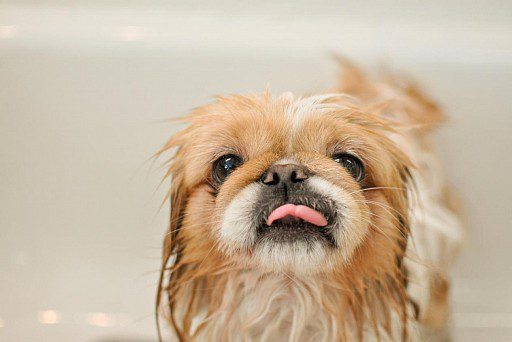

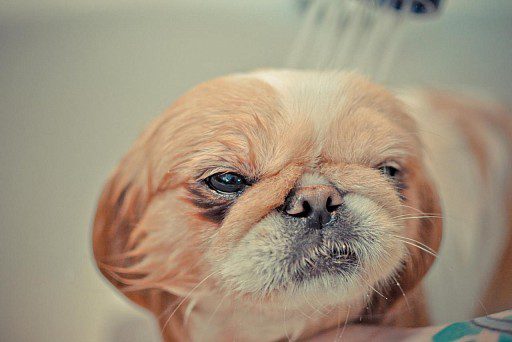

Pagpakaon
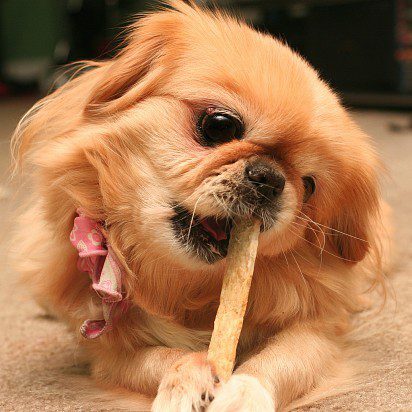

The main product in the diet of the Pekingese is lean meat, including turkey and chicken. Since any bones due to weak teeth are contraindicated for the breed, occasionally a dog can be pampered with cartilage. An excellent and healthy dish for the Pekingese is a raw / boiled tripe with previously removed fatty films, which can and should be combined with offal. Fish days are arranged for dogs twice a week (only cod fish fillets), and once every 7 days a pet is allowed to treat a hard-boiled egg yolk – whole or half, depending on the age of the dog.
As for cereals, it is useful to feed both puppies and adults. In the first case, oatmeal (flakes), millet in half with a gap and crushed rice groats are suitable. In the second – rice, less often – buckwheat. Any vegetables, stewed or raw, are also useful, as are fruits (exceptions are strawberries, kiwi, pineapple). It is very important to instill in the Pekingese a love for low-fat sour milk, which is often absent in puppies. It is better to start acquaintance with the products of lactic acid fermentation with home-made calcined cottage cheese. Vitamins and mineral supplements in the diet of the Pekingese, “sitting” on a natural menu, must be indispensable. However, it is better if a specialist picks them up, since when buying dietary supplements at random, there is a risk of hard hypervitaminosis for the animal.
For your information: the lifestyle and health of the average Pekingese do not allow him to waste large reserves of energy, although the breed does not suffer from a lack of appetite. Don’t indulge your four-legged friend’s food cravings too much if you don’t want to watch how the charming fluffy transforms into a fat, breathless and always sick lump.
Health and disease of the Pekingese
Of the inherited ailments in the Pekingese, urethritis, diseases of the heart valves, displacement of the intervertebral discs, a tumor of the perianal gland and eye diseases (ectropion, corneal ulcer, cataract) most often make themselves felt.
Sa unsa nga paagi sa pagpili sa usa ka itoy
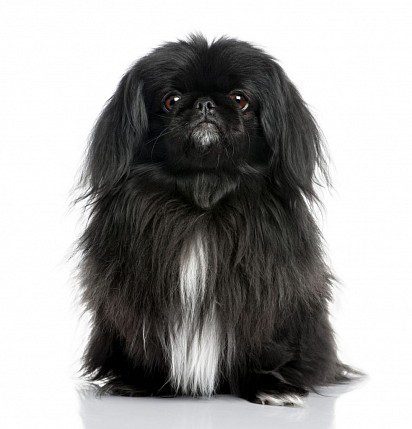

- Pekingese males and females almost do not differ in the type of temperament, but the appearance of the “boys” is more spectacular, since they shed less intensively (“girls” additionally shed their hair after childbirth and estrus).
- Don’t grab a puppy from the first breeder you see. It is better to evaluate several litters from different catteries.
- When purchasing a puppy for exhibitions, remember: the exterior potential of the Pekingese is visible by 6-8 months. If you brought a two-month-old baby into the house, the chances that a future champion will grow out of him are about 50/50.
- Examine the puppy’s parents, paying special attention to the eyes. In excessively goggle-eyed producers, the offspring inherit this feature, which is fraught with further loss of eyeballs in babies.
- If the puppies’ mother’s coat is not particularly glossy, this may be the result of postpartum molting. In this case, ask the kennel employee for a photo of the bitch before mating.
- Before buying, check if the Pekingese are dewormed and what vaccinations they have received. The appearance of the children is also important. Crumbs with wet eyes, hernias and dirty “patch” under the tail – this is not the most profitable acquisition.
- Check the puppies for marks. Usually the label is located on the stomach or ear.
- When buying in absentia “by photo”, discuss with the seller the possibility of returning the puppy. Photoshop works real miracles, so it is sometimes almost impossible to see a glamor model in a real Pekingese, whose image flaunted on the kennel website.
Photo of Pekingese puppies
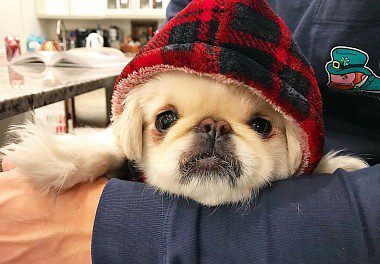

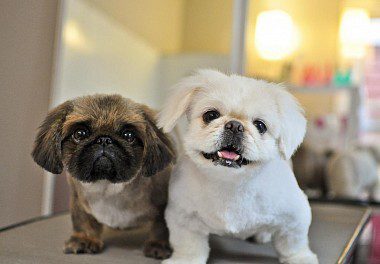

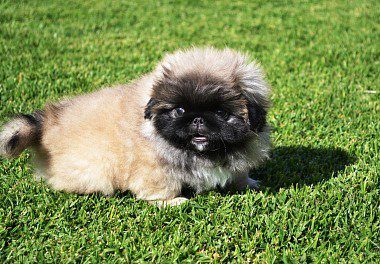

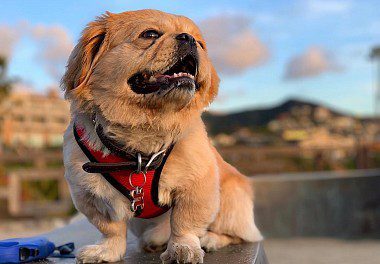

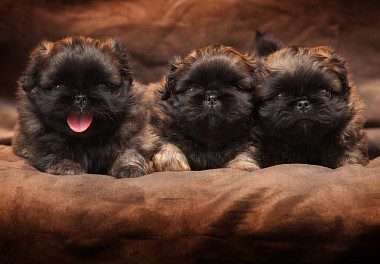

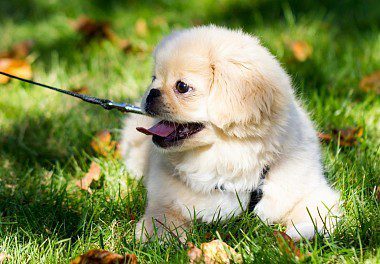

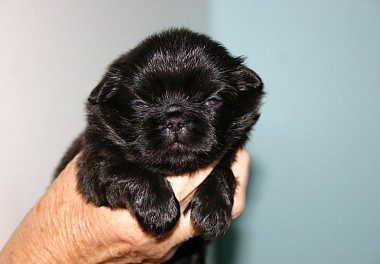

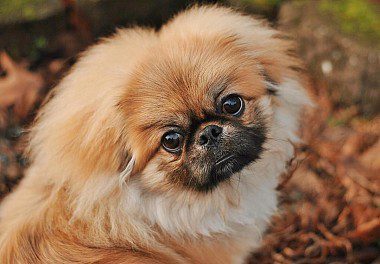

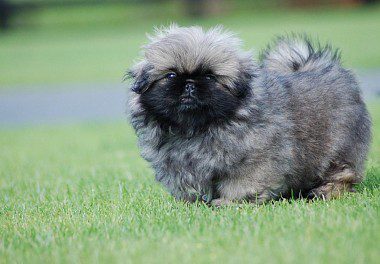

Pekingese price
The average cost of a Pekingese puppy in Russian kennels is 300 – 500$, but sometimes advertisements for the urgent sale of a litter pop up on the Internet, then the price tag can fall to 250$ or less. However, if you need a purebred Pekingese of a breed or show class, it is better to bypass all kinds of “promotions”, since a plembrace is usually sold in this way.





